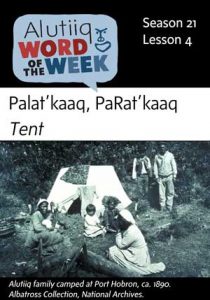 Palat’kaaq, PaRat’kaaq—Tent
Palat’kaaq, PaRat’kaaq—Tent
Akgua’aqu palat’kaami qawarciqua.—I am going to sleep in the tent tonight.
Kodiak’s archaeological sites indicate that the island’s first residents built tents. In some places, a selection of shallow post holes around a simple stone hearth suggests the use of temporary or even portable structures. In others, more permanent, circular dwelling made with low rock walls appear to have had a tent-like roof. These early structures were fairly small, covering an area of about 130 to 160 square feet, just big enough for a family. Parents and their children probably slept in these cozy skin-covered tents around a small stone-lined hearth. Oil lamps carved from sandstone provided additional light and heat.
Although Native people began to live in more substantial sod houses about six thousand years ago, temporary structures remained important for hunters, fishermen, and travelers. Elders report that a large spruce tree makes an excellent emergency shelter, and some recall covering themselves with a bear hide and sleeping on a bed of spruce branches. More formal shelters were made by piling spruce boughs over a framework of wooden poles or by stacking driftwood logs to form a three-sided structure that was covered with grass. Campers could build a fire in the entrance to the shelter and use piles of fresh grass for a comfortable mattress.
Source: Alutiiq Museum
